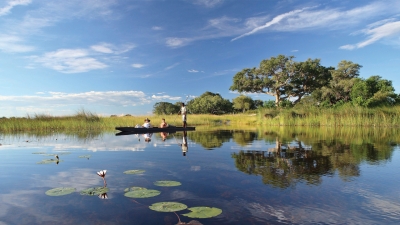
A delta of the Okavango River Basin, the region spreads across 6,000 sq km in northwestern Botswana of Africa. Comprising swamps, and plains that flood seasonally, this delta is one of the very few large inland delta systems that does not drain into the sea. Instead, it has an outlet into the sands of the Kalahari basin. During the dry season every year, the delta is fed by the Okavango River. And, the wildlife here is said to have adjusted their own life cycles according to this season, making this a great example of synchronisation between seasons and wildlife. The delta is much noted for its biodiversity, and is said to host one of the largest African elephant populations in the world. In addition to supporting populations of lions, cheetahs and wild dogs, it nurtures hundreds of species of birds. The region was declared a UNESCO World Heritage Site in 2014 and is also an Important Bird Area. This protected area is not without concerns. There has been a decline in the population of animal species and the reasons are not very clear yet. Also, there are no systems in place to protect the river outside of this country.
Wildlife
The delta boasts a variety of animals and birds. Among the birds that can be spotted here are ducks, geese, shelducks, teals, pochards, quails, francolins, flamingoes, grebes, pigeons, doves, sandgrouses, nightjars, swifts, coucals, cuckoos, moorhen, coots, swamphens, cranes, bustards, storks, pelicans, bitterns, herons, egrets, ibises, cormorants, thickknees, stilts, avocets, plovers, lapwings, jacanas, sandpipers. pratincoles, coursers, kites, buzzards, hawks, vultures, eagles, harriers, goshawks, owls, owlets, hornbills, hoopoes, honeyguides, rollers, kingfishers, falcons, kestrels, parrots. cuckooshrikes, oxpeckers, orioles, flycatchers, sunbirds, weavers, finches, sparrows, pipits, buntings, tits, larks, warblers, prinias swallows, martins, bulbuls, babblers, starlings, robins, wheatears, and thrushes. The place supports many endangered species too such as cheetah, the African wild dog and black and white rhinoceros. The other animals found here include the African elephant, African buffalo, giraffe, zebra, hippopotamus, crocodile, waterbuck, warthog, baboon, hyena, wildebeest, lion, leopard, caracal, and antelopes such as impala, lechwe, topi and sable.
Conservation outlook
According to the International Union for Conservation of Nature, the conservation outlook for the region has been assessed as “good with some concerns” in the latest assessment cycle (2020). This has remained thus since 2014. The delta is a vast and pristine wetland system that has largely been untouched by human-caused activity such as development work. In addition to its vastness, the region’s inaccessibility and “low human population densities” have helped in keeping it in a good condition. But it has a few concerns too. The most significant among them is the threat of poaching, as is evident from the decrease in the populations of certain mammals over the last 10 years or so. Of particular concern is the increasing poaching of elephants. Veterinary fences for disease control among animals were erected earlier, but they affected the movement of migratory animals in the region. However, some of these fences have been removed to ensure their free movement.
Picture Credit : Google




